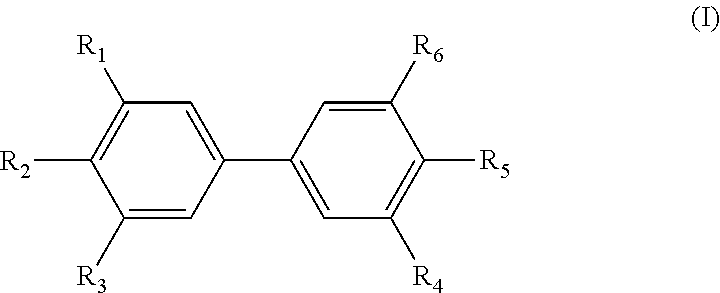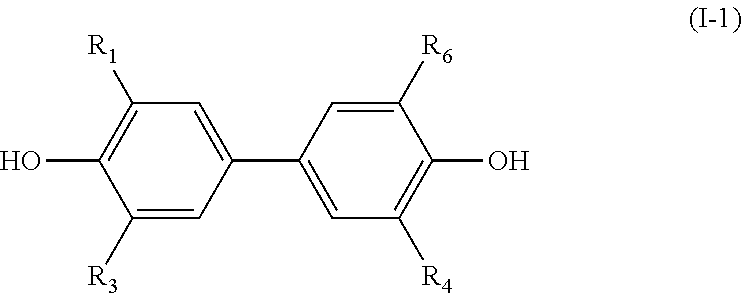Diphenyl derivative and uses thereof
- Summary
- Abstract
- Description
- Claims
- Application Information
AI Technical Summary
Benefits of technology
Problems solved by technology
Method used
Image
Examples
example 1
Compound 1: 4′-hydroxy-3,3′,5,5′-tetraisopropylbiphenyl-4-acetate
[0091]
[0092]Preparation procedure: 4′-Benzyloxy-3,3′,5,5′-tetraisopropylbiphenyl-4-acetate (5 g, 10.27 mmol) was dissolved in 200 mL methanol at room temperature, 10% palladium carbon (570 mg) was then added thereto, evacuated to vacuum and charged with hydrogen, which was repeated three times, and then sealed and reacted at room temperature for 10 h. The palladium-carbon in the reaction solution was filtered, and the filtrate was evaporated under reduced pressure to give 4′-hydroxy-3,3′,5,5′-tetraisopropylbiphenyl-4-acetate (3.9 g, 95.73%) as white solid. 1H NMR (300 MHz, CDCl3) δ 7.19 (s, 4H), 4.86 (s, 1H), 3.37-3.32 (m, 4H), 3.16 (s, 3H), 1.20 (d, 24H).
example 2
Compound 2: 3,3′,5,5′-tetraisopropylbiphenyl-4′-diacetate
[0093]
[0094]Preparation procedure: 4,4′-dihydroxy-3,3′,5,5′-tetraisopropylbiphenyl (5 g, 14.10 mmol) was added to 30 mL acetic anhydride and allowed to reflux for 3 h under nitrogen. The reaction solution was cooled to room temperature and the acetic anhydride was removed under reduced pressure. Water (200 mL) was added to the residue to give a white solid which was washed with 10% cold ethanol (100 mL) and water (200 mL) and dried to obtain 3,3′,5,5′-tetraisopropylbiphenyl-4′-diacetate (6 g, 95.06%), as white solid. 1H NMR (300 MHz, CDCl3) δ 7.19 (s, 4H), 2.91-2.89 (m, 4H), 2.32 (s, 6H), 1.19 (d, 24H).
example 3
Compound 3: 3,3′,5,5′-tetraisopropylbiphenyl-4,4′-bis(oxymethylene phosphate)
[0095]
[0096](1) 4,4′-dihydroxy-3,3′,5,5′-tetraisopropylbiphenyl (0.5 g, 1.4 mmol) was dissolved in dry THF (10 mL), solid NaOH (0.224 g, 5.6 mmol) and bromochloromethane (8.185 g, 84 mmol) was added thereto, and then refluxed under N2 for 2 h. The reaction solution was cooled to room temperature, filtered, and concentrated to give a yellow oil as intermediate.
[0097](2) Triethylamine (1.4 mL, 11.03 mmol) and 85% phosphoric acid (0.5 mL, 8.9 mmol) was added sequentially to 10 mL of anhydrous acetonitrile. The intermediate obtained in (1) was added to the acetonitrile solution under stirring, and then reacted at 65° C. for 2 h. The reaction solution was cooled to room temperature, the solvent was evaporated, and the residue was dissolved in 15 mL of water, adjusted to pH=1.5 with 8 M HCl, and extracted with anhydrous ether. The organic phase was combined, washed with saturated sodium chloride, dried over anhyd...
PUM
| Property | Measurement | Unit |
|---|---|---|
| diameters | aaaaa | aaaaa |
| temperature | aaaaa | aaaaa |
| pH | aaaaa | aaaaa |
Abstract
Description
Claims
Application Information
 Login to View More
Login to View More - R&D
- Intellectual Property
- Life Sciences
- Materials
- Tech Scout
- Unparalleled Data Quality
- Higher Quality Content
- 60% Fewer Hallucinations
Browse by: Latest US Patents, China's latest patents, Technical Efficacy Thesaurus, Application Domain, Technology Topic, Popular Technical Reports.
© 2025 PatSnap. All rights reserved.Legal|Privacy policy|Modern Slavery Act Transparency Statement|Sitemap|About US| Contact US: help@patsnap.com



